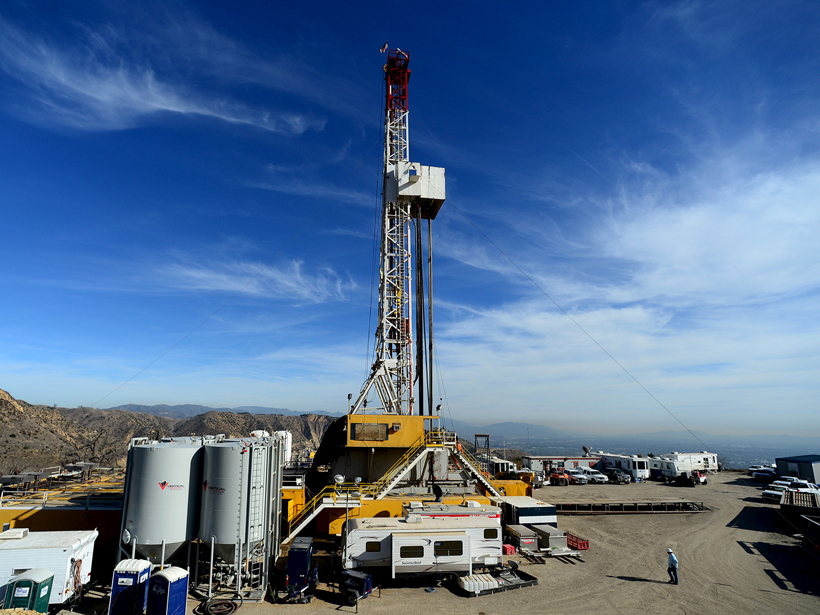In October 2015, a wellhead in the Aliso Canyon natural gas storage field, located in the Santa Susana Mountains in northwestern Los Angeles, Calif., suffered a breach in its casing. What followed was the largest natural gas leak in U.S. history.

By the time it was capped, 4 months later, the wellhead had spewed approximately 100,000 metric tons of methane into the atmosphere. At its peak, the blowout (also known as the Porter Ranch gas leak) effectively doubled the daily methane emission rate of the Los Angeles basin.
As most scientists turned their eyes skyward, focused on the atmospheric impacts of the leak, Patricia Tavormina, a research scientist at the California Institute of Technology, took the opposite approach. The leaking gas exited the well about 60 meters below ground, flowed through multiple conduits and channels in the soil, and escaped into the atmosphere, leaving behind soils saturated by natural gas.
Beginning in January 2016, Tavormina began collecting soil samples at the blowout site twice every month, cataloging the microbial communities in the soil and comparing them with samples collected in unaffected soils away from the leak. The results, presented Monday at the American Geophysical Union’s Fall Meeting in San Francisco, Calif., highlight drastically different bacterial communities in soils affected by natural gas compared with background samples. The gas-saturated soils contained high numbers of previously unrecognized members of Sphingobium bacteria that appear to consume methane in contaminated soil.
The first microbial study of a terrestrial natural gas leak, the research could eventually yield new approaches to treating contaminated soils.
Methane Munchers
“When there is an oil spill in the ocean, people catalog the microbes,” explained Tavormina. “But nobody was doing that here, and I thought it was a really valid question.”

To collect her first samples, Tavormina had to be escorted to the site by the well’s managers, the Southern California Gas Company. The well was still gushing natural gas, and she could smell it and hear it escaping. The first soil cores contained samples completely saturated with a mixture of methane (CH4) and ethane (CH3CH3) gases. Over the subsequent months, her samples tracked a microbial community in flux, from peak blowout through a slow return toward normal.
Tavormina compared the microbial communities from soils at sites with known methane outgassing from the leak with those far away, not exposed to the gas. The background soils revealed a standard community with about 1000 different genera that each represented less than 1% of the total population, although a few genera had abundances between 3% and 5%.
The gas-saturated soils, however, contained two genera with surprisingly high abundances: Sphingobium, which composed nearly 20% of the total community, and Massilia, which clocked in at nearly 13%.
“Neither of these bacteria have ever been shown to be involved with methane oxidation before,” Tavormina said. “This suggests that maybe there are pathways to methane oxidation in the soil that we were not aware of.”
From Field to Test Tube
Bacteria can be difficult to grow in a test tube after gas leaks, but in a stroke of good fortune, Tavormina was able to cultivate the Sphingobium in the lab.
The ability to culture the bacteria adds a unique facet to the research, said Molly Redmond, an assistant professor of biology at the University of North Carolina at Charlotte who was not involved in the research. “It allows her to conduct laboratory experiments to understand the metabolic function of the bacteria,” Redmond said.
Having cultivated Sphingobium in the lab, Tavormina can now explore direct, focused questions about the bacteria’s behavior. She has sequenced the bacteria’s genome and is running experiments to test the bacteria’s direct response to methane and ethane, both in pure culture and mixed with soil. As of now, she has not yet been able to culture the Massilia bacteria.
It is possible that these bacteria could consume enough of the natural gas to reduce the amount that gets released to the atmosphere.
So far, the experiments show that although Sphingobium can consume pure ethane, it does not consume pure methane. When mixed with soil, however, the microbes utilize methane through two different pathways of alkane oxidation. This suggests that the bacteria, if added to soil during a leak, could potentially siphon leaking natural gas from the soil before it reaches the atmosphere. This process is similar to what happened in the Deepwater Horizon oil spill, where lots of natural gas was consumed by bacteria in the ocean, Tavormina explained.
“In a smaller leak, it is possible that [these] bacteria could consume enough of the natural gas to reduce the amount that was released to the atmosphere.” said Redmond.
Reducing Emissions, Advancing Science
Limiting methane escape, of course, is the ultimate goal. Tavormina noted that California’s legislature recently passed a bill mandating a major cut to short-lived climate pollutants, including methane, which has a shorter atmospheric life but more intense impact than carbon dioxide. Her pioneering research could eventually help the state reduce its methane emissions in the event of future gas leaks.
What’s more, Tavormina also can start filling in gaps on bacteria’s phylogenetic tree. “This is the first time we have gotten one of these organisms from a massive event, so there is a lot of unknown, uncultured stuff,” she said.
—Aaron Sidder (email: [email protected]; @sidquan), Freelance Science Writer
Citation:
Sidder, A. (2016), Soil bacteria could help absorb natural gas leaks, Eos, 97, https://doi.org/10.1029/2016EO065061. Published on 14 December 2016.
Text © 2016. The authors. CC BY-NC-ND 3.0
Except where otherwise noted, images are subject to copyright. Any reuse without express permission from the copyright owner is prohibited.

